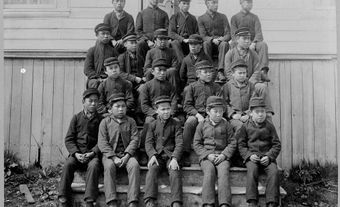Anti-racism education is an action-oriented educational strategy that emerged in Canada in the 1960s thanks to Black community members’ activism. The goal was to address racism and other related systems of social oppression in institutions like schools. Anti-racism educators in Canada address White supremacy and colonialism as factors behind today’s systemic racism. Over the years, anti-racism has evolved in Canadian schools to address educational racism and to discuss issues of equity, power, access, White privilege and systemic inequalities. Anti-racism initiatives continue to evolve in Canadian schools. They support students’ understanding of how to address racism while helping to create equity and societal change.
Definitions
White supremacy Ideology that White people are superior and should dominate society.
White privilege Unearned advantages that White people enjoy that allow them to have access to resources, which is unequal to any other racial group in Canada.
What Is Anti-Racism Education?
Anti-racism education is about recognizing, through teaching, the meaningfulness of race while examining the links between racism today and Canada’s history of colonialism. Racism is not only about individual acts of prejudice, violent attitudes, negative perceptions and stereotypes that people may have. Due to Canada’s colonial history, racism has been structurally embedded as a practice in schools. This is generally acknowledged as systemic racism and is reflected in the various ways that power and privilege work to discriminate against students who belong to minority groups.
Anti-racist educators recognize the history of race as a social construct. This means that the concept of race was created by people and does not have a scientific or biological basis; it does, however, have real social consequences. A key point about anti-racism education is that it is racism that makes race real. Issues of race and social difference are matters of power and equity. In other words, anti-racism education identifies a link between a person’s skin colour and their ability to access power and resources. Closely aligned with anti-racism education is the recognition and struggle against anti-Black racism: practices that impose racial hierarchies where Black people are at the bottom.
Anti-racism educators actively reflect on their teaching and any potential unintended biases. Anti-racism education is needed to address the challenges faced by non-White students and to encourage their success in the school system. It calls for educators to strive toward building an educational system that is equitable and free from racial injustice. It is also needed for educators to support White students to work in solidarity with their non-White peers. In more recent years, anti-racism education has been called upon to address questions of indigeneity and colonization. (See Indigenous Peoples in Canada.)
Racism in Canadian Education
Racism in Canadian schools is well documented. It began with the establishment of residential schools all over Canada in the 1800s and the implementation of racial segregation imposed on non-White students. (See Racial Segregation of Black People; Racial Segregation of Indigenous Peoples; Racial Segregation of Asian Canadians.) In recent years, Black and racialized students have been disproportionately suspended from school.
Canadian schools can be hostile places for Black, Indigenous and other racialized students for many reasons. Many students are “streamed” into academic levels below their capacities due to some teachers’ low expectations and discriminatory attitudes. Students do not see themselves represented in classes where only the history of European expansion is taught and where there is no diversity in class content or in educators. Students must ask for accommodations to attend holidays that are important to their cultural and religious communities. Racialized students are subjected to subtle everyday racism from peers and educators alike. When school is an unsafe place to be, this leads to students being pushed out.
White Supremacy in Education
Anti-racist educators engage with issues of power, identity and privilege to explain systems of inequality in society also found in schools. Anti-racist educators understand that, to create change in society, we must start by creating a commitment to anti-racism among students within classrooms. Anti-racism education engages the concept of White supremacy as one of the roots of contemporary racism. White supremacy was an important factor in the establishment of Canada as a nation and the privileges afforded to European colonists. Today, we understand this as White privilege.
White privilege does not mean that White people do not work hard; it means that they enjoy unseen and unconscious advantages. This allows them to have greater access to post-secondary education, professional development, health, safety and more. White privilege also reveals itself in schools when White students learn about the successes of their ancestors and see other White people in textbooks (unlike non-White students).
The purpose of anti-racism education is to question who has power in schools today and hold conversations with students to undo the legacy of White supremacy and privilege. Anti-racist educators reflect on the way that White privilege works to make inequities in society seemingly normal and natural. Anti-racism education advocates for changes in the curriculum so that students can learn about the devastating consequences of colonialism. Anti-racist educators want to teach the successes and value of many traditions around the world, not only those of Europeans. They also seek to question the inequities that are inherent in the existing education system so that students can see how they reflect inequity in society in general.
Development of Anti-Racism Education Through the Years
In Canada, some of the pioneering works on anti-racism education are attributed to Rosalie Silberman Abella, Agnes Calliste, Barb Thomas, Enid Lee, Carl James and George Dei. Anti-racism education arose in the early 1960s as a result of advocacy by parents, community members and academics. People organized partly to respond to the Multiculturalism Act enacted in 1988. Multiculturalism in education is the practice of addressing racism by celebrating diversity and inclusion. Advocates of anti-racism education argue that celebrating differences tends to ignore diversity within groups and does not lead to conversations about discrimination. The approach might also overlook how people’s differences are seen negatively as deficits or disadvantages.
Anti-racism education, on the other hand, addresses the reasons why discrimination exists. Educators examine how current violent attitudes and behaviours are the direct result of government policy and White supremacy. Anti-racism educators create lesson plans that encourage conversations about how we can make individual and societal changes.
Examples of Anti-Racist Initiatives
In 1993, the Ontario Ministry of Education and Training launched the Anti-Racism and Ethnocultural Equity in School Boards guidelines as a resource for school boards to develop and implement policies to identify and eliminate various forms of racism within their systems and schools. Since then, the anti-racism education movement has grown and progressed throughout Canada with positive institutional outcomes; however, racism is far from being eliminated.
An important anti-racist initiative was developed in the Region of Peel in Ontario, one of the most diverse regions in the province. In 1996, the Peel District School Board developed a policy document entitled The Future We Want: Building an Inclusive Curriculum to support teachers in creating an inclusive curriculum.
In Saskatchewan, Regina Public Schools developed ACT! Together We Make A Difference for schools to promote equitable relationships at various levels. (See Regina.) The program seeks to facilitate the development of youth and staff leadership to improve school-based anti-racist education and create respectful learning communities free from discrimination and racism for grades six to 12.
More recently, the Toronto District School Board launched a pilot Grade 12 course titled “Deconstructing Anti-Black Racism in the Canadian and North American Context.” (See Toronto; Anti-Black Racism in Canada.) The course curriculum was developed by educators D. Tyler Robinson, Tiffany Barrett, Remy Basu and Kiersten Wynter and will first be introduced to a few high schools, with the potential for wider instruction.
Anti-racist education is an ongoing commitment to positive and equitable outcomes in all education programs and services for all students.

 Share on Facebook
Share on Facebook Share on X
Share on X Share by Email
Share by Email Share on Google Classroom
Share on Google Classroom



